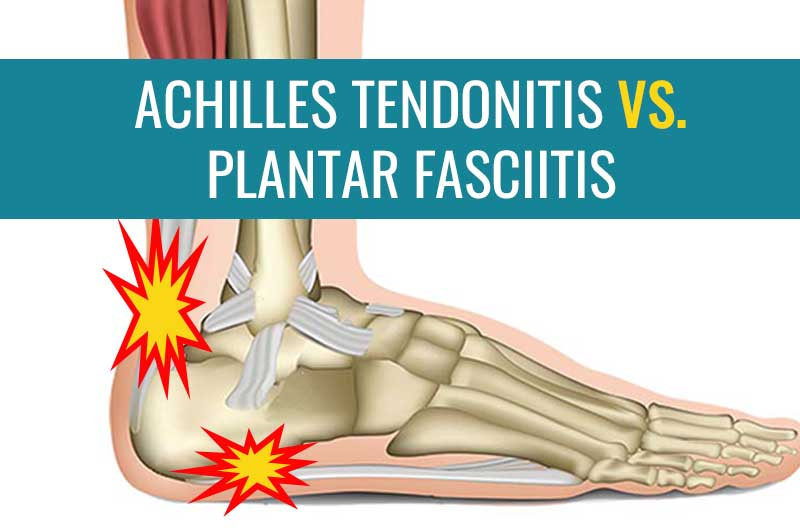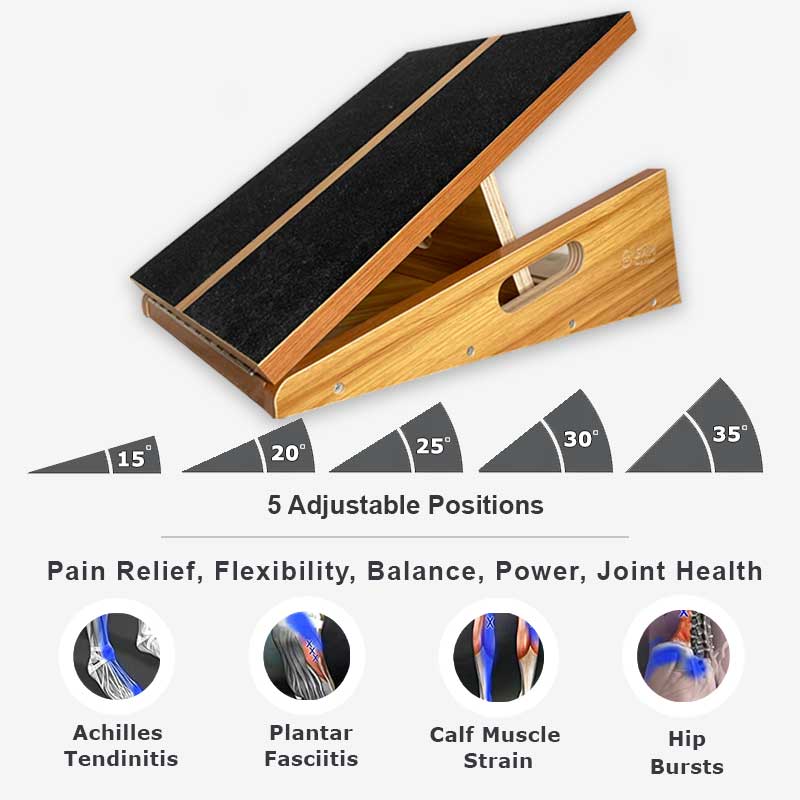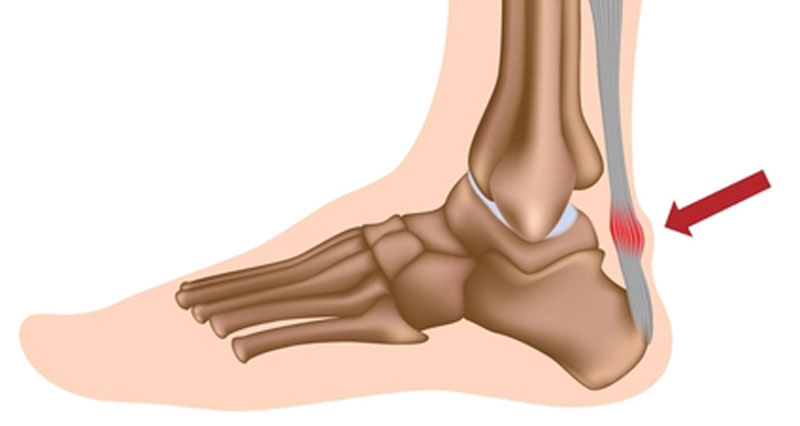Achilles tendonitis is a common condition that causes pain and stiffness in the heel and ankle area. It is caused by overuse or injury to the Achilles tendon, which is a thick band of tissue that connects the calf muscles to the heel bone. While rest and physical therapy are common treatments for Achilles tendonitis, using an Achilles stretcher or calf stretcher (compare on Amazon) can also help aid in recovery and prevent future injuries.
An Achilles stretcher, such as a slant board, calf stretcher or squat wedge, is a device that helps stretch the Achilles tendon and calf muscles. It can be used to reduce tightness and stiffness in the lower leg and improve the range of motion. An Achilles stretcher (or slant board) is excellent stretching equipment to help prevent future injuries by strengthening the muscles and increasing flexibility, as well as the recovery of those who already have Achilles tendonitis.
What are 3 signs of Achilles tendonitis?
The symptoms of Achilles tendonitis can vary depending on the severity of the injury. Some common signs include:
- Pain and stiffness in the heel and ankle area, particularly in the morning or after periods of rest.
- Swelling and tenderness in the affected area.
- Limited range of motion in the ankle.
If you are experiencing any of these symptoms, it is important to seek medical attention and start treatment as soon as possible.
How does a person get Achilles tendonitis?
Achilles tendonitis is often caused by overuse or repetitive strain on the tendon. Many athletes experience Achilles tendonitis or worst yet, rupture their Achilles tendon from over use from activities that involve a lot of jumping or running, such as basketball or distance running. These activities can put a lot of stress on the Achilles tendon and lead to injury. Wearing improper footwear or suddenly increasing the intensity or frequency of exercise can also increase the risk of developing Achilles tendonitis.
What is the fastest way to heal Achilles tendonitis?
There is no single “fastest” way to heal Achilles tendonitis, as recovery time can vary depending on the severity of the injury and individual factors such as age and overall health. However, there are several methods that can help speed up the healing process and reduce symptoms:
- Rest and immobilization: It is important to rest the affected area and avoid activities that put stress on the Achilles tendon. A brace or immobilizing boot may be recommended to keep the ankle stable and prevent further injury.
- Physical therapy: A physical therapist can help you perform exercises to stretch and strengthen the muscles in the affected area. This can help reduce pain and improve range of motion. A physical therapist may use an achilles stretcher, such as BAM’s Athletics Karma’s wooden slant board calf stretcher as a tool to aid in the recover. After consulting a medical professional, they may advise certain Achilles stretches to perform at home to help in the recovery. We’ve outlined a few popular Achilles stretches you can perform almost anywhere.
- Ice and heat therapy: Alternating between ice packs and heat therapy can help reduce inflammation and improve circulation to the affected area.
- Pain medication: Over-the-counter pain medications such as ibuprofen or naproxen can help reduce pain and inflammation.
What is the difference between Achilles tendonitis and plantar fasciitis?

On the other hand, plantar fasciitis is a condition that affects the plantar fascia, which is a thick band of tissue that runs from the heel bone to the toes. It is characterized by pain and inflammation in the heel area, and is often described as a sharp pain that is worse in the morning or after prolonged periods of standing or walking.
While the two conditions affect different parts of the foot, they can both be caused by overuse or repetitive strain. Additionally, both conditions can benefit from stretching and other forms of physical therapy. It is important to get a proper diagnosis from a healthcare professional to determine the best course of treatment for each condition.
Is walking good for Achilles tendonitis?
While it is important to rest the affected area to allow for proper healing, gentle exercise such as walking can help improve blood flow and promote healing. However, it is important to start slowly and gradually increase intensity as tolerated. Talk to your doctor or physical therapist before starting any exercise program.
How do you fix Achilles tendonitis?
Treatment for Achilles tendonitis typically involves a combination of rest, physical therapy, and other interventions as needed. In severe cases, surgery may be required to repair the damaged tendon. It is important to seek medical attention and follow a treatment plan to avoid further injury and promote healing.
Using an Achilles stretcher can also be a helpful addition to your recovery plan. Here are some benefits and exercises you can do with an Achilles stretcher:
- Stretching: Using an Achilles stretcher can help improve flexibility in the calf muscles and Achilles tendon. To stretch, place your foot on the stretcher and slowly lower your heel until you feel a stretch in the back of your leg. Hold for 30 seconds and repeat several times on each foot.
- Improved flexibility: Stretching on an Achilles stretcher can help to improve the flexibility of the calf muscles and Achilles tendon, allowing for greater range of motion and reduced risk of injury.
- Increased strength: By using an Achilles stretcher regularly, you can strengthen the muscles in your lower legs, improving your overall stability and balance.
- Reduced pain and discomfort: Achilles tendonitis can cause significant pain and discomfort, but using an Achilles stretcher can help to alleviate these symptoms by stretching and strengthening the affected area.
- Quicker recovery: Incorporating exercises on an Achilles stretcher into your recovery program can help to speed up the healing process, allowing you to return to your normal activities sooner.
An Achilles stretcher is a device that is specifically designed to stretch and strengthen the calf muscles and Achilles tendon. It is a highly effective tool for the treatment and prevention of Achilles tendonitis, a condition that affects the Achilles tendon and can cause pain, stiffness, and limited mobility.
What is an Achilles stretcher?

An Achilles stretcher is typically used by individuals who have suffered from Achilles tendonitis or other conditions that affect the Achilles tendon. The device is designed to provide a controlled and gradual stretch to the Achilles tendon, which can help increase flexibility and range of motion, reduce pain and inflammation, and prevent future injuries.
There are different types of Achilles tendon stretchers available on the market, including wedges, boards, and slant boards. These devices are often made of sturdy materials such as wood or plastic, and feature a sloped surface that elevates the heel and provides a gentle stretch to the Achilles tendon.
Some Achilles stretchers as BAM’s slant board come with additional features, such as 5 adjustable angles, strong non-slip surface grip to help keep the foot from sliding, and bottom anti-scratch pads to protect the floor. BAM’s slant board calf stretcher also offers a portable or mobile 3-piece hard foam calf wedge, which is another excellent achilles stretching tool.
The additional hard foam 3-piece calf wedge or achilles stretcher is engineered to provide a controlled and effective stretch to the calf muscles and achilles tendon. It’s engineered of strong durable foam with slot wedges that allow each calf wedge to combine together to increase the angle and stretch for effective achilles tendon stretching.

The 3-piece achilles stretching wedge is designed for adjustability and customization, with each piece being able to be rearranged or removed to accommodate different levels of flexibility and comfort.
This allows for a more personalized achilles stretching experience that can be tailored to the needs of each individual user.
Additionally, the calf wedge material provides a stable and secure platform for stretching, helping to prevent slips or falls during the stretching process. Using a hard foam 3-piece calf wedge as part of a comprehensive stretching routine can help increase flexibility, reduce muscle soreness and tightness, and improve overall athletic performance.
Stretching on an Achilles tendon stretcher is often recommended as part of a comprehensive treatment plan for Achilles tendonitis, and can also be beneficial for athletes or individuals who are at risk of developing Achilles tendon injuries.
What are some exercises to help prevent or recover from Achilles tendonitis?
Here are some exercises that you can do on an Achilles stretcher:
- Standing Calf stretch:The standing calf stretch is a simple yet effective exercise that can be performed on an Achilles stretcher. To do this exercise, follow these steps:
- Stand on the Achilles stretcher with your toes pointing forward and your heels hanging off the edge.
- Slowly lower your heels toward the ground, feeling a stretch in your calf muscles and Achilles tendon.
- Hold the stretch for 20-30 seconds, then slowly raise your heels back up.
- Repeat this exercise 3-4 times, gradually increasing the duration of the stretch as your flexibility improves.
- Eccentric heel drops:Eccentric heel drops are another effective exercise for treating Achilles tendonitis. This exercise involves controlled lowering of the heels to stretch the Achilles tendon, followed by a quick return to the starting position. Here’s how to perform this exercise:
- Stand on the Achilles stretcher with your heels hanging off the edge.
- Slowly lower your heels toward the ground, feeling a stretch in your calf muscles and Achilles tendon.
- Once your heels reach the lowest point, quickly raise your heels back up to the starting position.
- Repeat this exercise 10-15 times, gradually increasing the number of repetitions as your strength improves.
- Single leg raises: Single leg raises are a more advanced exercise that can help to improve strength and flexibility in the calf muscles and Achilles tendon. Here’s how to perform this exercise:
- Stand on the Achilles stretcher with one foot on the ground and the other foot resting on the stretcher.
- Slowly raise the foot on the stretcher off the ground, feeling a stretch in your calf muscles and Achilles tendon.
- Hold the stretch for 5-10 seconds, then lower your foot back down to the starting position.
- Repeat this exercise 10-15 times on each leg, gradually increasing the duration of the stretch as your strength improves.
Incorporating these exercises into your regular stretching routine can help to improve the recovery and prevention of Achilles tendonitis. However, it’s important to remember that these exercises should be performed under the guidance of a qualified healthcare professional to ensure proper form and to avoid injury.
If you are looking to buy an achilles stretcher for the home or office, there are several different types of Achilles stretchers available, including Achilles tendon stretchers, Achilles stretcher boards, and Achilles wedges. More commonly known as a slant board or calf stretcher, each of the latter devices are slightly different to target different exercises for rehab . Each of these devices has its own unique benefits and features, so it’s important to choose the right one for your needs.
Using an Achilles stretcher is a safe and effective way to treat the recovery and prevention of Achilles tendonitis. However, it’s important to consult with a qualified healthcare professional before beginning any new exercise or stretching program. They can help you to determine the best course of treatment for your specific needs, and ensure that you are using the Achilles stretcher correctly and safely.








